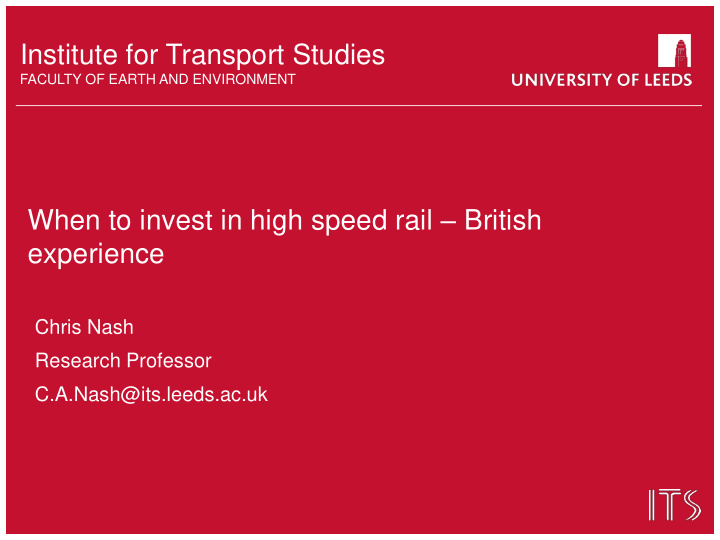



Institute for Transport Studies FACULTY OF EARTH AND ENVIRONMENT When to invest in high speed rail – British experience Chris Nash Research Professor C.A.Nash@its.leeds.ac.uk
HS1 benefits and costs (£m) Benefits (1998 Appraisal) User benefits -International 1800 Services User benefits - Domestic Services 1000 Road Congestion 30 Environmental benefits 90 Regeneration 500 Total Benefit 3420 Costs 1990 NPV 1430 BCR 1.72 (excluding regeneration benefits) 1.5
HS1 outcome • 30% shortfall in patronage depressed user benefits • Subsequent estimates of regeneration and other wider economic impacts much greater than in the original appraisal • But are they reliable? Do the regeneration benefits reflect net gains or reallocation?
The Atkins study in Britain- results Figure 1.1
Appraisal of Options 1 and 8 (£bn PV) Option 1 Option 8 Net revenue 4.9 20.6 Non financial benefits 22.7 64.4 Released capacity 2.0 4.8 Total benefits 29.6 89.8 Capital costs 8.6 27.7 Net operating costs 5.7 16.3 Total costs 14.4 44.0 NPV 15.3 45.7 B/C 2.07 2.04 Source Atkins (2003) Summary report, Addendum, Table 2.1 with transcription errors corrected
HS2 Standard appraisal – discounted costs and benefits (over 60 years) ( £ b 2011 prices) Source: DfT (2013) Phase One Full Network Oct 2013 Oct 2013 Transport benefits 16,921 40,529 (Business) Transport benefits 7,673 19,323 (Other) Other quantifiable 407 788 benefits Indirect taxes (loss to -1,208 -2,912 Govt) Net transport benefits 23,793 57,727 Wider economic impacts 4,341 13,293 Total costs 29,919 62,606 Revenues 13,243 31,111 Net cost to Government 16,676 31,495 Benefit cost ratio (inc 1.7 2.3 WEIs)
Debates about routeing • Chilterns versus M1 corridor • Old Oak Common, Euston or St Pancras? • How to link to Heathrow? • How to link to HS1? • Out of town sites for Sheffield (Meadowhall) and Nottingham-Derby (Totton)
Criticisms of appraisal 1.Unrealistic demand forecasts (2.5% growth p.a. to 2036) 2.Overstated value of business time savings 3.Failure to examine adequately cheaper alternatives 4.Debate about wider economic benefits
Incremental benefits and costs compared with 51M proposal 51M Y shaped increment Benefits 7.108 46-52 Costs to gov 1.173 25-23 BCR 6.06 1.6-2.3 Source: derived from Atkins (2012)
Average change in connectivity by region in 2037 after investment in HS2 Source: KPMG (2013) City regions Change in labour Change in business connectivity by rail connectivity by rail Derby-Nottingham 14.7% 23.2% Greater 1.4% 18.8% Manchester Greater London 6.9% 8.8% South Yorkshire 31.8% 22.5% West Midlands 15.7% 21.1% West Yorkshire 9.1% 19.7% Rest of G. Britain 5.3% 11.3%
KPMG estimate of impact on GVA • KPMG regress labour productivity on rail connectivity using cross section data • Finds a strong relationship, suggesting that HS2 will add £15b p.a. to UK GVA • But rail connectivity highly correlated with car connectivity and other aspects of city centre location • How can these effects be disentangled?
Conclusions on HS2 - The central business case looks strong, but is a BCR of 2 adequate in current budgetary conditions? - Like any megaproject, HS2 requires decisions in the face of great uncertainty. - Value of business travel time and wider economic benefits savings priorities for further research
Recommend
More recommend